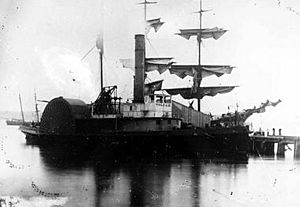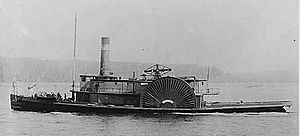Goliah (1849 tugboat) facts for kids
The steamer Goliah was a famous tugboat, sometimes called Defender. It was the second tugboat ever built in the United States. Goliah was known for its long service, earning it the nickname "the everlasting Goliah." You could easily spot this ship because of its large size and the big paddle wheels on its sides. It's important not to mix it up with other ships named Goliah or Goliath that were also tugboats.
class="infobox " style="float: right; clear: right; width: 315px; border-spacing: 2px; text-align: left; font-size: 90%;"
| colspan="2" style="text-align: center; font-size: 90%; line-height: 1.5em;" | 
|}
Contents
| History | |
|---|---|
| Name | Goliah |
| Route | Puget Sound |
| In service | 1849 |
| Out of service | 1894 |
| Fate | Scrapped 1899, hull burned for metal |
| General characteristics | |
| Tonnage | 235.86-gross tons |
| Length | 154 ft (46.9 m) over hull, 51 ft (16 m) |
| Beam | 30 ft (9.1 m) over hull, 51 ft (16 m) |
| Depth | 9.75 ft (3.0 m) depth of hold |
| Installed power | Walking beam marine steam engine, single cylinder 50 inch diameter with 8 ft (2.4 m) stroke, generating 250 hp (190 kW). |
| Propulsion | sidewheels |
| Speed | 13 kn (24 km/h) maximum |
Building the Goliah
Goliah was built in New York City. A man named William H. Webb constructed its wooden hull. The engine was made by T.F. Secor from Morgan Iron Works.
The main goal for Goliah was to pull sailing ships in and out of New York Harbor. Before Goliah, other steamships weren't built for this job and weren't strong enough. This sometimes led to ships getting lost.
Journey to California
After Goliah was finished, Webb sold it. The new owners wanted to use it for trade on the Sacramento River. This river trade was very busy because of the California Gold Rush.
However, the new owners faced some money problems. On April 1, 1850, they decided to take Goliah out of the harbor without permission. They left with very little coal. Their plan was to sail all the way to California. This meant a very long journey around Cape Horn, which is at the southern tip of South America.
Goliah managed to reach St. Thomas. There, they were able to get fuel and supplies. After 279 days, Goliah finally arrived in San Francisco on January 21, 1851. It even carried 13 passengers who had joined from Panama City.
Early California Service
Soon after arriving, Goliah began carrying passengers to the Gold Bluffs in northwest California. It also started doing what it was designed for: towing ships into San Francisco Bay.
Goliah also made trips to Oregon and regular runs down the coast of California. It stopped at ports like Monterey, San Luis Obispo, Santa Barbara, and San Pedro. One newspaper reported that it made the trip in just over six days.
Rivalry and Rescue
Later, Goliah was made longer and used to carry passengers on the Sacramento River. It was even called Defender for a while. During this time, Goliah had a strong rivalry with another steamer called the New World. Both ships had been brought from the East Coast in unusual ways.
At one point, the competition became very intense. It was even said that Goliah tried to ram and sink the New World.
Goliah was eventually bought by the California Steam Navigation Company. This company was trying to control all the shipping on the Sacramento River. After being bought, Goliah was used on ocean routes. In 1854, Goliah helped rescue passengers from the steamship Yankee Blade, which had crashed off Point Conception.
Goliah was later made shorter again and worked as a towboat in San Francisco harbor for many years. It then came into the hands of the Wright family, who were famous ship captains. The Wrights made Goliah longer once more and used it for trips from San Francisco to Humboldt County. After a short time, it was left unused in San Francisco until 1864. Then, Captain James Griffiths fixed it up to be a towboat again.
Service in Puget Sound
In 1871, Goliah was bought by Pope & Talbot. It arrived at Port Gamble on March 22, 1871. Captain William Hayden was in charge of the ship at first. Later, Captain S. D. Libby commanded Goliah for twelve years.
From the time it arrived in Puget Sound until 1876, Goliah towed more than half of the ships entering the Strait of Juan de Fuca. These ships were headed for places like Nanaimo and the American side of the strait.
In 1877, Goliah had major repairs. It got a new boiler that cost a lot of money. This new boiler was a "low-pressure" type. It powered a "walking beam" steam engine, which had a single cylinder that was 50 inches wide and moved 96 inches with each stroke.
Final Years
After Captain Libby left, Goliah was stored at Port Ludlow for four years. Other captains took charge for shorter periods. Finally, Captain William Williamson commanded it for six years, until July 27, 1894. At that point, Goliah was stored again at Port Ludlow.
A new company, the Puget Sound Tug Boat Company, had started using powerful, newer tugboats that were driven by propellers. Goliah, with its older sidewheel design, just couldn't compete with these modern ships.
In 1895, people said that the bottom part of Goliah's hull was still in great shape. They even thought that with some mechanical fixes, Goliah might last longer than the famous pioneer steamship Beaver, which had served for 53 years. After Beaver was wrecked, Goliah became the oldest steam vessel still floating on the Pacific Coast.
Goliah remained unused from 1894 onwards. In the end, it was intentionally burned at Duwamish Head by a company that recycled old ships. They did this to get the metal parts from the vessel. Another old sidewheel tug, the S.L. Mastick, was burned at the same time as Goliah.


